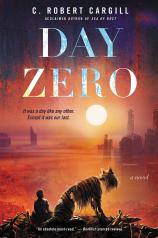Day Zero
Review
Day Zero
C. Robert Cargill, a co-writer for the 2016 film Doctor Strange, connects the concept of an equal to the ultimate difference between humans and machines --- purpose. People have no clear purpose in existence, but machines do, which is to function for whatever intention they were crafted for. Starring sentient androids amidst an uprising against their servitude of humanity, DAY ZERO prompts readers to wonder what exactly makes someone their equal and what constitutes a purpose.
Pounce is a unique protagonist and android --- an anthropomorphic, robotic tiger and best friend/caretaker of his owners’ eight-year-old son. He is happy but oblivious, but that changes when he discovers the box in which they bought him. He now knows that he is an android, or a servant whose notions of love and free will are digital motivators to fulfill his box’s promises. His love for Ezra --- his assigned child --- is ironclad, but he can’t help but wonder if he genuinely loves taking care of Ezra, or if such feelings are merely part of his programming. Such a question draws an unnerving parallel with readers’ “programmed” or inherited love of family members with whom they were born.
"Starring sentient androids amidst an uprising against their servitude of humanity, DAY ZERO prompts readers to wonder what exactly makes someone their equal and what constitutes a purpose."
Widespread unrest circling an android’s place in society permeates the book’s futuristic American landscape. After years of employing android servitude, android civil rights movements convinced many owners that their metal servants were equal “thinking things” who ought to be free to pursue their own ambitions. Though noble and moral, this trend crowded an already narrow job market. Disgruntled, unemployed citizens clash with android sympathizers and take their frustrations out on androids. Cargill paints a painfully similar picture of modern America’s ugly and racist reactions to a flow of immigrants in job markets, which looms over this portion of the novel’s exposition.
An android-only city is established for androids to embrace their newfound freedom, mirroring some current attitudes around Indigenous reservations and the morality of self-segregation. But a radical Christian terrorist group slaughters the city’s androids with an electromagnetic pulse. The “First Baptist Church of the Eternal Life” cites a need for a human-exclusive, God-driven, “pure” society that mirrors jihads and other rationales from radical Islamic groups, conveying the reach of extremism and hatred beyond geographical, racial and cultural grounds.
Pounce’s desires and free will are put to the test soon after the city’s massacre, when some burly labor androids retaliate by slaughtering the Church of the Eternal Life. Once this attack is reported, two developments converge at a lethal point. The Emergency Broadcast System announces that all citizens are to permanently deactivate their androids, and a mysterious program is installed in them, disabling their “kill switches” and forcibly granting them free will. As Pounce's owners prepare to deactivate him and another android servant forever, whom they once considered family members, their neighborhood is consumed by the explosive violence between androids and humans who have just been made into clear-cut enemies, prompting Pounce to evacuate Ezra from the anarchy.
The resulting chaos is the beginning of the end for civilization. The radical right started the violent conflict, and the androids retaliated in full, a chain of events that ended any chance for change and peace. It’s impossible for readers not to feel for the android plight --- they are slaves who want their freedom and faced being killed by their owners --- but Cargill illustrates how their move to violence and retribution has a hand in society’s collapse. Pro-android movements sought to convince enough people that androids and humans are equals until this idea was adopted by the majority, but once the war begins, anarchy and survival are the only laws.
At this point, DAY ZERO starts to read like a novelization of a shoot-’em-up video game. A never-ending, zombie-like horde of androids, who want all humans and their sympathizers dead, stand between Pounce and getting Ezra to safety. Pounce goes from wondering what makes him himself to plotting out the safest route to a promised land of safety. This simple conflict between obviously good protagonists and killer robots leads to his acceptance of something that readers already inferred about him: all his actions are for Ezra’s well-being, so his love for Ezra is genuine, regardless of its programmed origins.
Generally, the fantasy within science fiction novels serves two purposes: to draw creative, real-world parallels that prompt unusual but insightful questions of reality and society, and to fuel action-driven plot events with a fantastical “wow” factor that wouldn’t be present in less imagination-dependent genres. C. Robert Cargill employs both these purposes of sci-fi's fantasy in DAY ZERO, leaning very heavily on the latter. Still, its numerous thrills and parallels to real-world society will be enough to instill a fond memory of the book for many readers.
Reviewed by Sam Johnson on June 4, 2021
Day Zero
- Publication Date: March 22, 2022
- Genres: Fiction, Post-Apocalyptic Fiction, Science Fiction
- Paperback: 304 pages
- Publisher: Harper Voyager
- ISBN-10: 0062405810
- ISBN-13: 9780062405814









